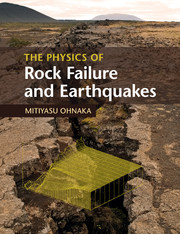Book contents
- Frontmatter
- Contents
- Preface
- 1 Introduction
- 2 Fundamentals of rock failure physics
- 3 Laboratory-derived constitutive relations for shear failure
- 4 Constitutive laws for earthquake ruptures
- 5 Earthquake generation processes
- 6 Physical scale-dependence
- 7 Large earthquake generation cycles and accompanying seismic activity
- List of illustration credits
- References
- Index
5 - Earthquake generation processes
Published online by Cambridge University Press: 05 April 2013
- Frontmatter
- Contents
- Preface
- 1 Introduction
- 2 Fundamentals of rock failure physics
- 3 Laboratory-derived constitutive relations for shear failure
- 4 Constitutive laws for earthquake ruptures
- 5 Earthquake generation processes
- 6 Physical scale-dependence
- 7 Large earthquake generation cycles and accompanying seismic activity
- List of illustration credits
- References
- Index
Summary
Introduction
When an external stress is applied at a slow and steady rate to an inhomogeneous material in the brittle regime, fracture eventually begins to occur locally somewhere in the material, and the elastic strain energy stored in the medium surrounding the rupture front is released. If the released strain energy is much greater than the resistance to rupture growth, the released energy is expended not only as the driving force for the rupture to grow further but also as kinetic energy. As a result, the rupture extends spontaneously beyond external control, and dynamically at high speeds close to elastic wave velocities (unstable, dynamic rupture in the brittle regime). We often come across such brittle fractures in everyday life: for example, the fracture of fragile bodies such as glass. However, a typical large-scale example of brittle fractures would be the earthquake rupture instability that takes place in the brittle layer of the Earth's crust.
Most earthquakes occur at shallow depths in the brittle regime, and shallow focus earthquakes are caused by slip-failure mechanical instabilities that give rise to dynamically propagating shear ruptures on preexisting faults in the seismogenic layer. In the past, such an earthquake rupture in the brittle regime has been thought to begin to propagate abruptly at high speeds close to elastic wave velocities immediately after the onset of the rupture.
- Type
- Chapter
- Information
- The Physics of Rock Failure and Earthquakes , pp. 121 - 178Publisher: Cambridge University PressPrint publication year: 2013



